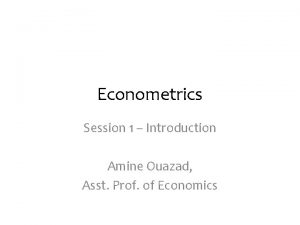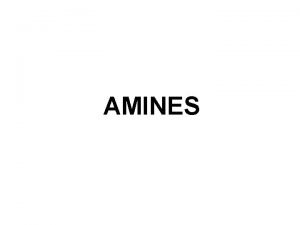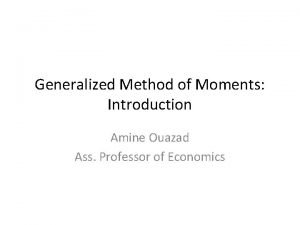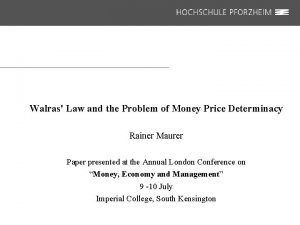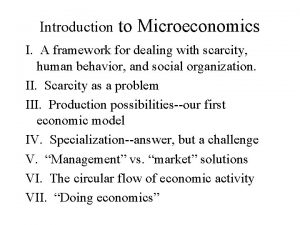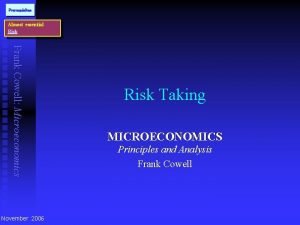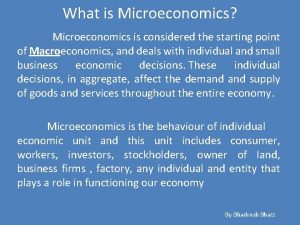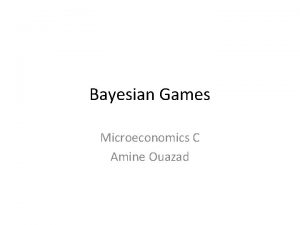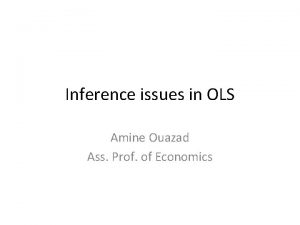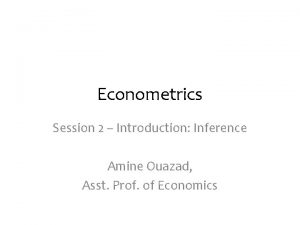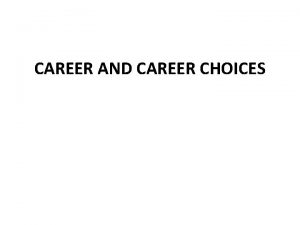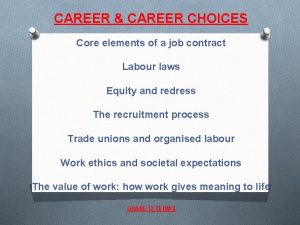3 Screening Amine Ouazad Microeconomics C Career Choices























- Slides: 23

3. Screening Amine Ouazad Microeconomics C

Career Choices • A real estate broker wishes to hire an agent. He posts a job offer. • Initially, the dealer was offering 50, 000 euros a year, fixed. What was/were the problem? • The compensation is as follows: – The salesman gets 1% of all sales, and an additional fixed wage of 30, 000 euros. – The average price of a house in the area is 150, 000 euros. • Who accepts the offer?

Push a little further • What is the optimal contract? • The real estate broker is greedy: max Revenue – Wage. • The productive candidate has options: Wage >= productive broker’s outside option. • The unproductive candidate has (worse) options: Wage >= unproductive broker’s outside option. • What is the optimal wage contract, assuming it is a fixed percentage + a flat wage?

Outline 1. Asymmetric information on the labor market (done) 2. Screening car rental customers: Explicit price discrimination 3. Screening airline customers: Implicit price discrimination 4. Screening eclectic and obsessive customers: Bundling

P P High valuation customers Lower valuation customers Optimal price MC MC Variable profit “No money is left on the table” Variable profit MR Uniform Pricing Demand Q Q Perfect Price Discrimination “A key step is to avoid uniform pricing. Pricing to specific customer groups should reflect the true competitive value of what is being provided. No money is left on the table. . . ” A. Miles, Pricing, Boston Consulting Group.

Spot the Difference

2. Explicit Price Discrimination Segment the market by observable characteristics. Charge customers in different segments different prices, according to their elasticity. Condition #1: Market Power • Must have ability to set prices Condition #2: Observability (No deception) • Use an easily observed trait which is correlated with elasticity of demand. • Customer cannot masquerade as someone else. Condition #3: No arbitrage/resale • Customers from one segment cannot sell good to others.

Explicit Price Discrimination - Condition #2: Observability • Tourists pay more for kilims in Istanbul than locals. • Students get discounts on air/rail tickets. • Californians pay $97; non-Californians pay $151 for a 2 -day park hopper • Dell Inspiron 580, Base Configuration: Home: $749 Small Business: $899 • Victoria’s secret?

Condition #3: No Arbitrage

Railroad freight pricing U. S. railroads charge 1. 5 -2 times as much to move coal as they do to move grain per ton; 90 Coal PC = 90 - 10 QC MC = $10 Grain PG= 60 - 5 QG 60 PC MC 10 MRC = 90 -20 QC = 10 = MC QC = 4 PC = $50 PG MRG = 60 -10 QG = 10 = MC QG=5; PG = $35 Higher choke price → Less Elastic → Higher price

Outline 1. Asymmetric information on the labor market 2. Screening car rental customers: Explicit price discrimination 3. Screening airline customers: Implicit price discrimination 4. Screening eclectic and obsessive customers: Bundling

2. Implicit Price Discrimination The Mother of All Discriminatory Pricing: Airline Pricing Airlines like to segment the market based on valuations, but valuations are not observed § On the other hand, valuations are correlated with time sensitivity § In general consumers with higher valuation are less likely to accept: • Saturday night stay • A 14 -day advance ticketing , . . etc. § Solution: Create a product line based on artificial restrictions. These simply annoy the customers, and have little or no bearing on their cost of operation

Screening with Differentiated Products Scenario: Airline has B business customers and L leisure customers. Valuation Type of Customer Unrestricted Restricted Business $1000 $600 Leisure $600 $500 Cost per ticket = $ 300 (Same for restricted and unrestricted tickets) – Explicit Market Segmentation –

Pricing of Only Unrestricted Tickets Option 1: Charge $1000 and sell only to Business travelers Profit = (1000 -300)*B = 700 B Option 2: Charge $600 and sell to both Business and Leisure Profit = (600 -300)*(B + L) = 300 (B + L)

Screening with Restricted & Unrestricted Tickets Option 3: Charge $900 and sell unrestricted tickets to Business travelers Charge $500 and sell restricted tickets to Leisure travelers Profit = (900 -300)*B + (500 -300)L = 600 B + 200 L This is Screening or Implicit Market Segmentation

Comparison of 3 Options (A) sell only unrestricted tickets at a price of ______ to business travelers only; Profit: (B) sell only unrestricted tickets at a price of ______ to all travelers; Profit: (C) sell unrestricted tickets to business travelers for ______ and restricted tickets to leisure travelers for _____. Profit:


Wrap Up • Even if you cannot explicitly segment the market don’t lose heart – implicitly segment the market! • Offer a menu of options and try to come up with a creative screening mechanism • Try product differentiation, versioning, inter- temporal pricing, damaging, bundling (see this next time) – these achieve price discrimination

Outline 1. Asymmetric information on the labor market 2. Screening car rental customers: Explicit price discrimination 3. Screening airline customers: Implicit price discrimination 4. Screening eclectic and obsessive customers: Bundling

Bundling • Selling several goods in one bundle üHardware and software üSoftware suites üSports/Concert tickets üAuto accessories

Exercise 6. 6: Screening via Bundling Pricing of a two-concert mini season (Wagner and Harbison) at a theater. Highly segmented, with only three types of customers: Valuation Type of Customer Wagner Verdi A $50 $5 B $40 C $5 $50 A customer may go to one or both of the concerts.

– Benchmark: Explicit Market Segmentation – – No Bundling –

– Pure Bundling – – Mixed Bundling – The Genius of Dell? ?
 Amine ouazad
Amine ouazad Amine ouazad
Amine ouazad Amine
Amine Method of moments estimator
Method of moments estimator Ouazad
Ouazad Ouazad
Ouazad How do career choices affect your income
How do career choices affect your income Career choices and preferences in hrm
Career choices and preferences in hrm Formulas for career success career testing & investigation
Formulas for career success career testing & investigation 16 national career clusters framework
16 national career clusters framework What is the subject matter of microeconomics
What is the subject matter of microeconomics Cowell microeconomics
Cowell microeconomics Microeconomics
Microeconomics Walras' law
Walras' law Microeconomics ia
Microeconomics ia Circular flow diagram menggambarkan
Circular flow diagram menggambarkan Cowell microeconomics
Cowell microeconomics Micro macro economics
Micro macro economics Importance of microeconomics
Importance of microeconomics Almost essential
Almost essential Uses of microeconomics
Uses of microeconomics Externalities and public goods microeconomics
Externalities and public goods microeconomics 22rents
22rents What is microeconomics
What is microeconomics

